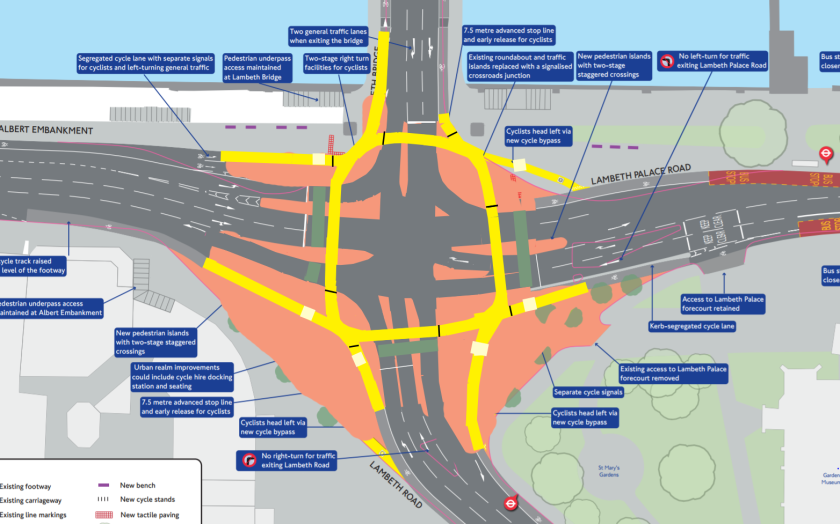Catching up with the latest TfL consultations, I was a combination of delighted and exasperated to see the proposals for Lambeth Bridge.
Delighted, because they reveal the political will to provide for cycling and walking, even if it means sacrificing a tiny bit of motoring capacity at these junctions.
Exasperated because even when the will is there, the technical capacity clearly isn’t. Just look at it.

Look at that splurge of tarmac.
TfL had a blank canvass here. They’re completely rebuilding the junction, which is currently a roundabout. The kerblines are going, the trees are moving, the drainage will have to be redone. It’s not like any compromise is being made to work within the constraints of what’s there now.
It reveals a lot about how TfL’s designers are approaching these problems. They had a blank canvass and they filled it with tarmac. Then they asked where they needed to fit some kerbs into it. Walking and cycling is still being designed to fit around the edges of motoring, which remains the natural rightful state of our streets.
And look at the absurd mess that has led to.
Look at the entry to Lambeth Bridge. They’ve painted an arrow on it to tell motorists to get out of the cycleway. How on earth did that happen? According to the diagram, there is only ever one lane of traffic able to head onto the bridge at any time. How did they get themselves into a situation where people might be driving in the cycle lane and need to be told to get out of it?
Look at the entry into Albert Embankment. What is that lane merge arrow painted on that grossly distended carriageway space for? Again, there is only one lane of traffic entering this street at a time.
These kinds of tarmac oceans, with arbitrary shifting kerblines and unclear routes through them, are why British junctions are confusing, stressful and dangerous — whatever mode of transport you’re using. There is a large area of tarmac here that in theory should never ever be used, even by the largest and longest vehicles, because there are no legal manoeuvres that would use the space, or at least, that wouldn’t normally and more safely and sensibly be performed using some other space. But what that tarmac does do is provide opportunities for people to make mistakes, to perform illegal manoeuvres, or to behave dangerously. The gaping wide entries into Lambeth Bridge and Albert Embankment do nothing for a law-abiding motorist except create confusion about where they’re supposed to be, but they do invite idiots to use the turn lanes and cycle spaces to jump queues or to make illegal turns.
What might this junction look like if designed with a less motor-centric philosophy?
Instead of washing an undercoat of carriageway all across the blank canvass, you’d start from the opposite default. The canvass is blank and the only carriageway you add to it is the carriageway that’s needed to accommodate the manoeuvres that are possible here. Who are the users who need to move through the junction, and where do they need to move from and to? Draw the paths that they will need to take through the junction.
Draw the paths that motorists would take through this space if following the turn restrictions and if following the most rational routes. Work out how you’d cycle around it, and how you’d walk around it. The result looks a lot like Dutch crossroads do.

This kind of design enables all of the same turns that TfL’s design legally allows, and has exactly the same number of motor traffic lanes feeding into and out of each arm of the junction. Capacity for legal manoeuvres should be the same (but the illegal turns, lane misuse and simple mistakes encouraged by TfL’s original design become much more difficult). I’m not saying necessarily that this is what I’d want the junction to look like, because I wouldn’t necessarily accept the same demands of motor capacity as TfL, but if you do accept the demands TfL are working to, this is roughly how the junction would work if cycling were properly designed for.
The one impact I haven’t addressed with my crayons is that they would have to address turn conflicts across the cycleways — something that wouldn’t be an issue if we had normal priority rules. But there are multiple options available to solve that problem TfL could call upon — indeed, they already solve it in their own design, for traffic/cyclists exiting Albert Embankment, with a separate turn signal.





